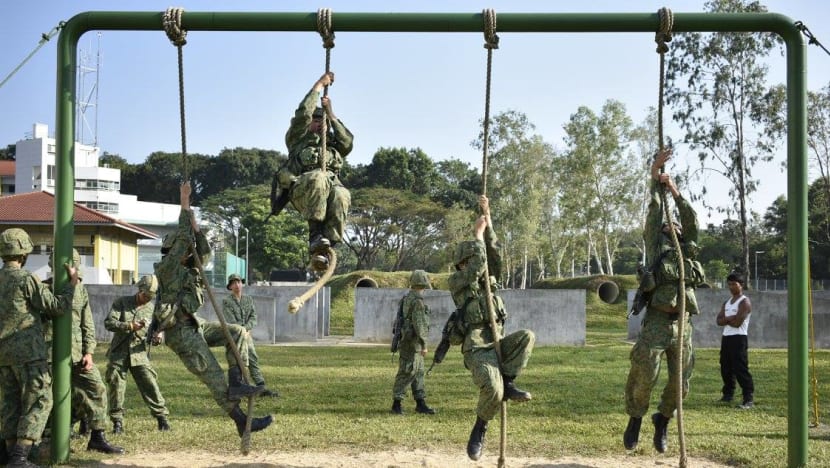A temperature 'pill' to monitor soldiers? What the SAF is doing to combat heatstroke

Singapore Armed Forces (SAF) soldiers training on a low rope station on Dec 28, 2022. (Photo: Facebook/Ministry of Defence)
SINGAPORE: Imagine ingesting a tiny device that gives real-time updates of your body temperature. It is, in fact, a scene that is already being played out among selected soldiers in the Singapore Armed Forces (SAF), as part of efforts to mitigate the impact of heat stress.
Defence Minister Ng Eng Hen on Wednesday (Jan 11) officiated the launch of the Heat Resilience and Performance Centre (HRPC), which aims to address the "long-term challenges of maintaining human performance amid rising temperatures in the region and the world".
Located on the premises of the National University of Singapore (NUS) at the Yong Loo Lin School of Medicine, the centre is a collaboration between SAF, NUS and DSO National Laboratories.
It will leverage best-in-class local and global expertise, including thermal physiologists and climate researchers, the three organisations said in a joint news release on Wednesday.
WHY THE NEED FOR THE HRPC
The HRPC was first announced at the Committee of Supply debate in March 2022.
"It is obvious that SAF needs this facility to make it safer for our soldiers to train and operate in the hot humid climate of Singapore and elsewhere," said Dr Ng on Wednesday.
In 2018, a full-time national serviceman died nearly two weeks after displaying signs of heat injury following a fast march at Bedok Camp.
An external panel review that year found that the SAF's heat injury measures were “generally sound and aligned with prevalent industry and foreign military practices". In its report, the total number of heat injuries declined from 27 in 2012/2013 to 20 in 2017/2018.
The Heat Resilience and Performance Centre - set up by the Singapore Armed Forces, National University of Singapore and DSO National Laboratories - aims to be a global leader on thermal research. Lauren Ong with more.
However, heatstroke cases - while dropping from eight to five in the same period – saw a rise from zero cases in 2015/2016 to five in 2017/2018.
"Thankfully because of our new heat injury preventive measures, we have not had a heatstroke fatality for the last 4 years," said Dr Ng.
These measures collectively have brought down the occurrence of heat exhaustion cases over the last decade, with more than 50 per cent reduction in some years and there has been zero heatstroke cases since 2019, he added.

Dr Ng also said that heat cooling measures such as adequate hydration and arms immersion in ice water are now standard practice, adding that attention is paid to adequate rest cycles and early signs of heat stress.
He also described how temperature "pills" were being administered to selected soldiers, to allow their core temperatures to be continuously measured by commanders using a handheld device.
"If you go on for a 10km route march, you may start out fine. But anywhere along the route march, if you are susceptible to heatstroke, how can we tell? Especially if the whole battalion is there, how do I monitor each one as each one is precious," said Dr Ng.
"We want to be able to detect this so that we can stop the activity if any soldier's core temperature exceeds a threshold."
GLOBAL WARMING
Dr Ng also acknowledged rising temperatures in recent years and Singapore's position on the equator: "This challenge will be even harder in the future because of global warming."
With this in mind, HRPC's vision to be a global leader in thermal research centred on helping humans "thrive in a warming world" is focused on three key thrusts:
- "Discover" - This aims to build a robust data ecosystem to drive research discovery and hypothesis testing for heat resilience using big data aggregation, analytics, and new knowledge.
- "Detect" - This will visualise and make sense of an individual's heat health status to predict the risk of injury by identifying prediction markers and artificial intelligence.
- "Strengthen", which focuses on developing state-of-the-art tools and tech-enabled approaches to boost heat resilience through advanced material technologies and mitigation and management strategies.
"Let me try to ignite a new passion that what you are doing makes a real difference, translates to lives saved because remember, soldiers have died because of heatstroke," Dr Ng said.
"That must be our ultimate motivation to prevent every death."
















